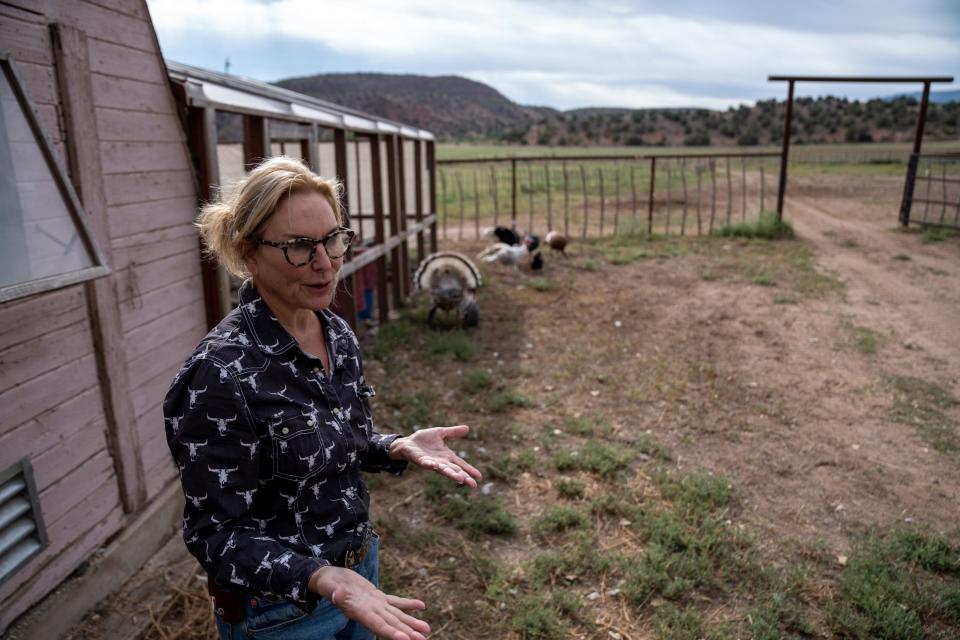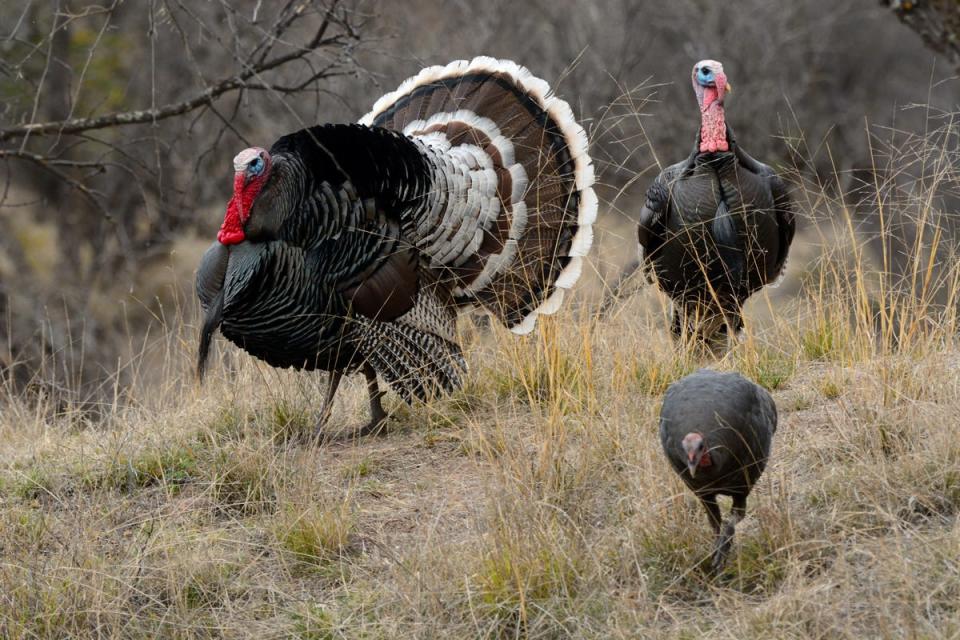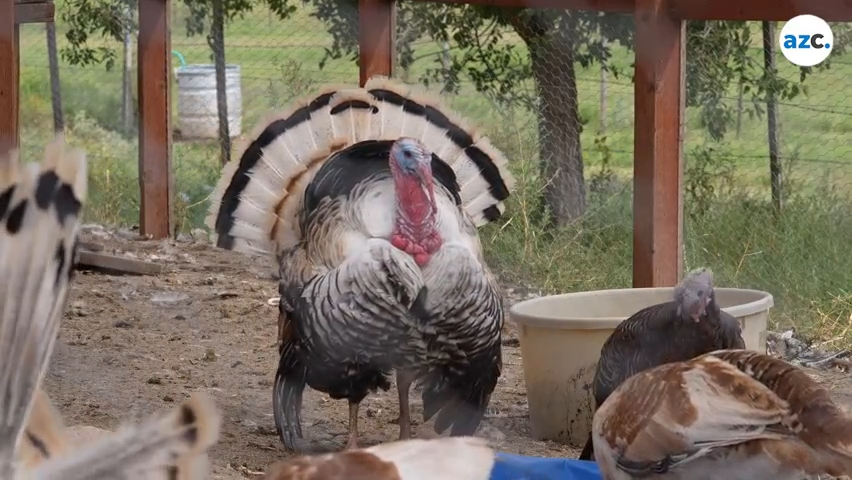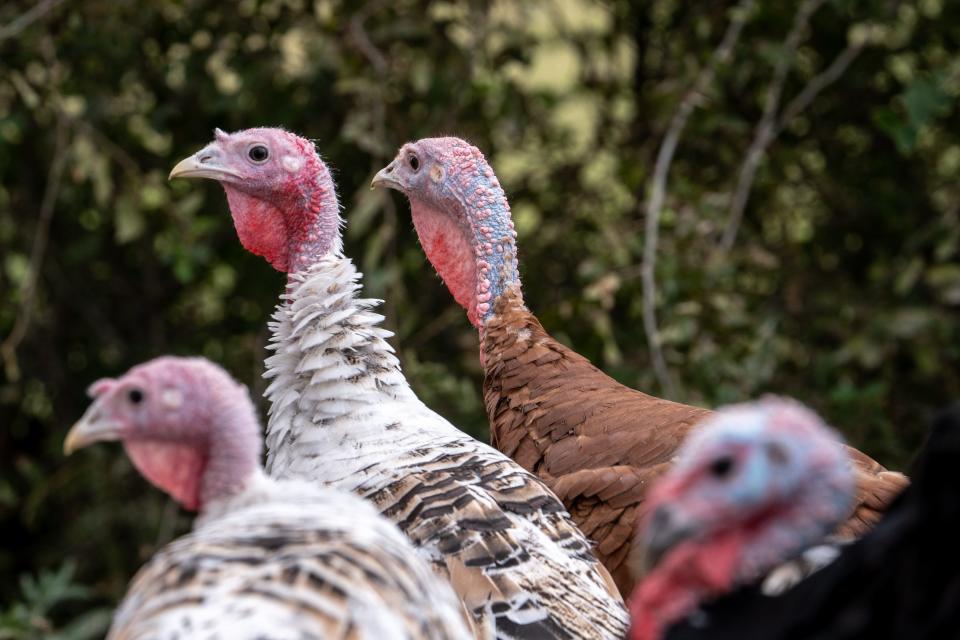The only egg-to-table Arizona turkey farm raises birds for Thanksgiving greatness
Turkeys are an icon of the Thanksgiving table. The National Turkey Federation estimates 46 million frozen turkeys are consumed each year. Although frozen, mass-produced birds are the most efficient option for distributing that staggering number of fowl each November, they aren't the only option.
When grocery store turkeys are frozen, the moisture inside the muscle freezes. Ice crystals expand and change the texture. After defrosting, moisture escapes from the meat, leaving it drier than if it had been cooked fresh. This causes a deterioration of both texture and flavor. That's one of the reasons former chef Michael Muthart decided to start his own poultry farm, Top Knot Farms, in southern Arizona, near Tucson.
"They are free to feed on bugs and grass and that makes them taste better," Muthart said.
He, like most Arizona farmers, raises his turkeys from poults or chicks imported from other states, finishing them with grain feeding in preparation for Thanksgiving. He does this rather than keeping the large birds all year long as it's simply too expensive to do so and the demand is highly seasonal.
But that hasn't stopped one Arizona rancher.

A heritage turkey ranch in Arizona
Even after a three-hour drive from Phoenix, it requires another 25 miles on a pitted dirt road to access the oasis that is Moon River Beef Ranch. Dogs chase the few cars that appear, wagging their tails in greeting. The lush, rolling green hills surrounding the ranch make it hard to believe it exists in the same state known for saguaro, red rocks and sandstone towers. It’s peaceful, bucolic, magnificent, which is what drew Lisa Khan there in the first place.
Khan is a divorce attorney who’s working on her final cases. Though she does not come from a family of ranchers, owning one was a childhood dream. She purchased the Perkinsville property in 2013 and began raising cattle and selling them at auction. During the drought in Yavapai County, which coincided with the pandemic, beef prices dropped and she pivoted to selling directly to restaurants like Tarbell's and Persepshen. She also began selling chicken, eggs and turkeys.
Each fall, her heritage breed turkeys, which she raises from eggs, take center stage. Khan said she cross-breeds the large birds "for optimal flavor and tenderness."
Moon River Beef has stands at Uptown, Downtown and McDowell Mountain farmers markets where Khan typically sells 60 to 70 turkeys between Thanksgiving and Christmas. Her stock of toms weigh 18 to 20 pounds and hens weigh 15 to 18 pounds. She sells out every year. But they're hardly a payday.
“It’s really expensive to feed these guys,” she said. “We just do it because it’s fun. Turkeys are fun and they are pretty. It’s just a hobby.”

Heritage turkeys aren't the same as wild turkeys
While a wild turkey may be a heritage breed, the heritage turkeys raised for the Thanksgiving table are not wild and often aren't even the same subspecies.
According to the Arizona Department of Game and Fish, Arizona is home to three subspecies of wild turkeys. Gould’s is the largest in size with long legs. Its blue-green feathers contrast with a white tail and rump feathers. Rio Grande, which were “recently introduced at Black Rock Mountain," have pink-tinged breast and tail feathers. Merriam’s turkeys, which are native to the Western U.S., mainly northern Arizona, New Mexico and Colorado’s ponderosa pine forests, are known for the white feathers on their lower backs and tails and bodies covered in black with purple, blue and bronze feathers.
Although wild turkeys are unlikely to end up on the holiday table, anthropologist Amber Sampson, the Indigenous Foodways Facilitator at the Pueblo Grande Museum in Phoenix, said they do have significance for Indigenous people. They traditionally roasted, stuffed and stewed the large fowl and used its feathers for making cloaks, headdresses and arrow fletching. For the O'odham people, turkeys represent the rain spirit and are believed to predict the weather, in just one of turkeys' many appearances in lore.
Domestic turkeys, which typically have white feathers, are originally from southern Mexico and a different subspecies altogether, according to the Smithsonian Conservation Biology Institute.
When it comes to eating wild turkeys, they are far more muscular, as many can even fly, which means dense, tougher meat. Game birds also enjoy haphazard diets of natural nuts, berries and insects as do heritage breeds. In addition, farm-raised turkeys feed on grains to help them develop specific flavors.
Whether heritage or wild, turkeys are one of the oldest American culinary traditions. "Large domesticated animals, such as horses and cattle, were not native to the Americas," said Sampson. "Thus, an accessible food supply, such as the turkey, which provided seasonal winter game, and supplies from its feathers and bones, was a helpful resource, worthy of respect."

Raising turkeys in Arizona
Muthart pasture-raises domestic, broad-breasted turkeys, because he feels fresh poultry tastes better, period. Khan focuses on her heritage breeds for their darker meat and richer taste.
“These turkeys have a lot of intermuscular fat and it just makes the meat taste beautiful,” she said.
Whether raised from poult or egg, ranching turkeys in Arizona is a unique undertaking.
At Moon River Beef ranch, the toms strut through the grounds, tail feathers fanning open, blue faces giving way to red wattles. In their pens, they jump and gobble to establish dominance.
Inside the pen, hens give a staccato cawing, known as an assembly call, audible amid the males’ loud gobbles, which are interspersed with clucks, purrs and putts.
Each year, Khan chooses toms and hens to breed for next year’s flock, and she marks them accordingly.
The heritage breed turkeys she’s been raising were considered adolescents at four months old, so the enclosed hatchery is bare in the weeks leading up to Thanksgiving, as the turkeys are old enough to be outside. Come early spring, a new breeding cycle will begin and she'll outfit the area with bedding for the chicks.
Her process is very different from raising the turkeys found in most grocery stores. Commercial birds are genetically engineered to mature in only 14 to 16 weeks and are fed a diet of corn and soybean meal mixed with vitamins. According to the Humane Society, most are confined to 2.5-cubic feet per of space per bird.
Khan's turkeys graze on 50 acres of irrigated pasture where they eat "bugs and grass, eggs and vegetables from the garden," she said. At a certain point, she begins to restrict their activity to some extent to avoid the development of tough meat.
She said it takes about 48 days from breeding to hatching, followed by six months of feeding before they are table-ready.
According to Khan, the biggest challenge of raising turkeys in Arizona is sourcing the right food for her birds. "Arizona does not grow feeds that are appropriate for poultry," she said.

How to cook heritage turkey, according to the rancher who raises them
When it comes to cooking heritage breed turkey, Khan recommends skipping the conventional cooking methods that call for 15-20 minutes of cook time per pound, as it can lead to drier meat.
She offered the following tips:
Rinse and dry your turkey, then allow it to rest under foil for 1½ to 2 hours before cooking to bring it up to room temperature.
Slip pads of softened, unsalted butter under the skin of the turkey between the skin and the meat. This will make the skin golden and crisp and keep the turkey meat moist.
Keep seasoning simple. Slather generously with salt and pepper, both on the outside and inside the cavity.
Place breast side down in a roasting pan fitted with a grill, so the turkey is not sitting in its juices).
Do not stuff. Cook your stuffing or dressing separately.
Do not cover with foil as that will make the meat poach or steam.
Cook in a pre-heated 375 degrees F oven.
To prevent heat loss, base the turkey only once, around the halfway cooking point. The butter rub under the skin should provide ample moisture to prevent drying out.
Turn the bird over after 1 ½ hours of cooking and use a thermometer to check the temperature regularly to avoid overcooking.
Once the internal temperature in the thickest part of the thigh reaches 140 degrees F, remove the turkey from the oven and let it rest for 30 minutes. During this resting period, the internal temperature will rise to a safe and perfect 150 degrees F.
Step away from the oven. Order your holiday dessert from these metro Phoenix pie shops
Reach the reporter at BAnoshahr@azcentral.com. Follow @banooshahr on X, formerly known as Twitter.
This article originally appeared on Arizona Republic: Thanksgiving turkeys taste better from this Arizona ranch. Here's why

